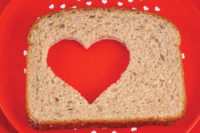National Nutrition Month is here once again, and this year’s theme is “Get Your Plate in Shape.” In honor of the first National Nutrition Month (NNM) since the release of MyPlate, this March is dedicated to reminding consumers about the importance of following MyPlate’s guidelines, with a special emphasis on calorie balance and portion control.
The Grain Foods Foundation is excited to support the Academy of Nutrition and Dietetics (AND) and its National Nutrition Month outreach. We have a number of activities planned to reinforce grains’ key place in MyPlate.
During the month of March, our focus will be on grains’ role in providing energy and maintaining a healthy weight. We will also highlight the important nutrients provided by grains, such as folic acid, iron and fiber. In our communications, we will leverage the expertise of the advisory board, especially that of Glenn Gaesser, PhD, who is an expert on fitness and health. This will include proactive media outreach offering Dr. Gaesser as an expert resource on grains nutrition in the context of MyPlate, a handout on grains and energy that will be available on gowiththegrain.org and strategic social media conversations.
We have also aligned our social efforts with the influencers at AND (formerly the American Dietetic Association) by participating in its NNM blogroll. By blogging on the topic of “Get Your Plate in Shape,” we have the opportunity to feature AND’s NNM badge on our blog, Six Servings, throughout March; we will also be listed with other nutrition influencers in AND’s NNM blogroll that will drive directly to Six Servings. We will augment this with NNM-focused conversation on GFF’s Facebook and Twitter channels.
Finally, the GFF recently became a member of the Center for Nutrition Policy and Promotion’s National Strategic Partnership. This has been a wonderful opportunity to connect with nutrition influencers across the food industry while elevating the many benefits of grains consumption in the national nutrition dialogue. CNPP relies on its network of strategic partners to support the Dietary Guidelines for Americans with a focus on specific messages during key periods in the coming months. This multi-year public health campaign is dedicated to sharing easy-to-understand nutrition information with consumers; the key message we’re supporting during NNM is “Enjoy your food, but eat less” to reinforce the need for calorie balance and achieving/maintaining a healthy weight.
In light of this message, I leave you with these tips on ways to “Get Your Plate in Shape” from dietitians at AND and GFF. I encourage you to share them with friends, family and colleagues this National Nutrition Month:
Make half of your plate fruits and vegetables: Eat a variety of vegetables, especially dark-green, red and orange varieties. Add fresh, dried, frozen or canned fruits to meals and snacks.
Make at least have your grains whole: Choose 100% whole-grain breads, cereals, crackers, pasta and brown rice or those with significant levels of whole grains (8 g. or more per serving). Check the ingredients list on food packages to find whole-grain foods. Your other grain servings should be enriched grains to get the additional thiamin, riboflavin and folic acid.
Switch to fat-free or low-fat milk: Fat-free and low-fat milk have the same amount of calcium and other essential nutrients as whole milk, but less fat and calories. For those who are lactose intolerant, try lactose-free milk or calcium-fortified soy beverages.
Vary your protein choices: Eat a variety of foods from the protein food group each week, such as seafood, nuts and beans, as well as lean meat, poultry and eggs. Keep meat and poultry portions small and lean. And be sure to choose seafood as the protein at least twice a week.
Cut back on sodium and empty calories from solid fats and added sugars: Compare sodium in foods and choose those with lower numbers, and season your foods with herbs and spices instead of salt. Switch from solid fats to healthy oils like olive and canola oil. Replace sugary drinks with water.
Enjoy your foods but eat less: Avoid oversized portions. Use a smaller plate, bowl and glass. Cook more often at home where you are in control of what’s in your food. When eating out, choose lower calorie menu options.
Be physically active your way: Adults need at least two hours and 30 minutes of physical activity every week. Choose activities that you enjoy, and start by doing as much as you can.




